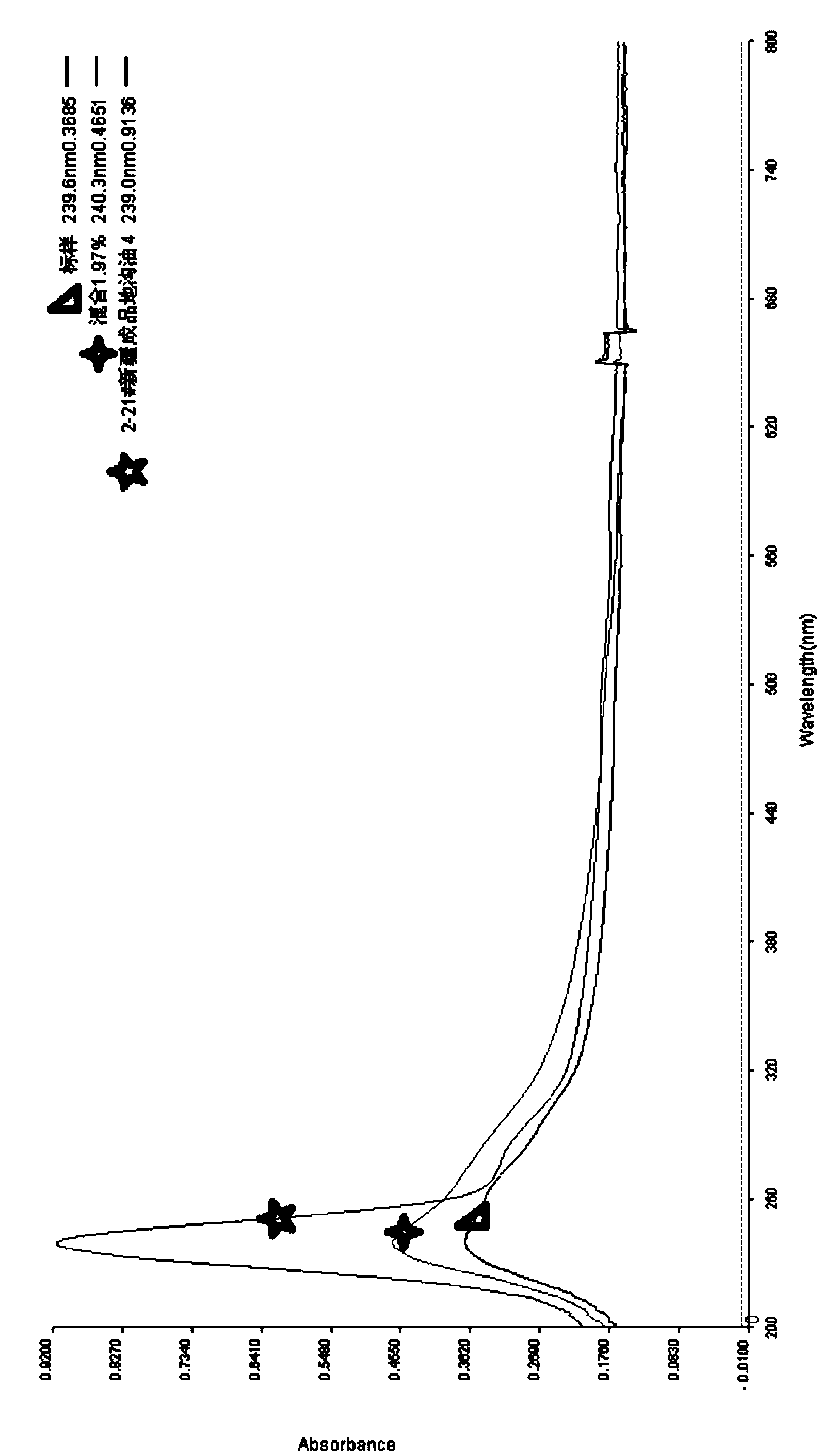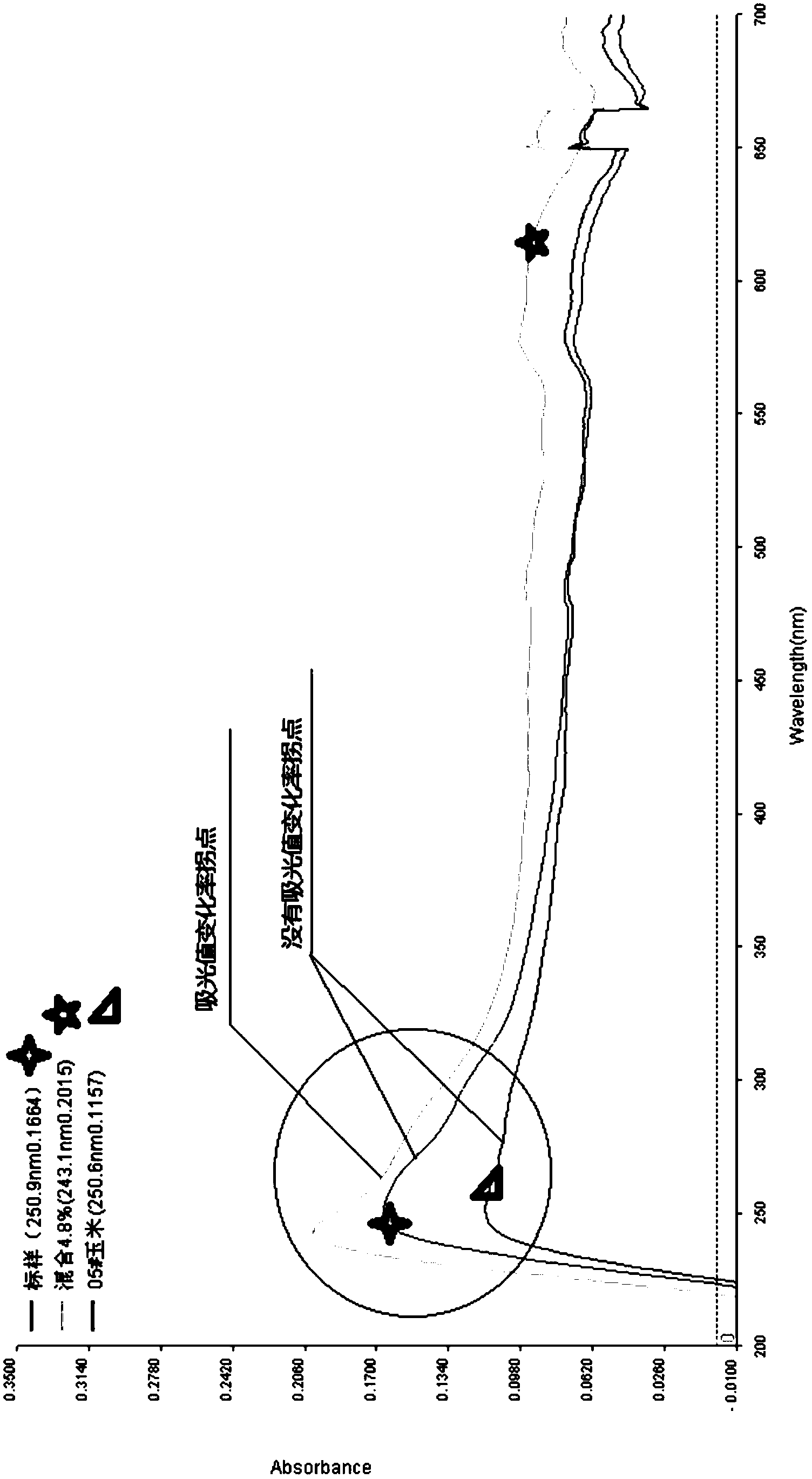Method for carrying out illegal cooking oil detection by using ultraviolet spectroscopic analysis method
An ultraviolet spectrum and analysis method technology is applied in the field of waste oil detection by using the ultraviolet spectrum analysis method, which can solve the problems of expensive detection methods, low specificity of waste oil detection results, and inability to be practically applied, and achieves rapid identification, simple method effect
- Summary
- Abstract
- Description
- Claims
- Application Information
AI Technical Summary
Problems solved by technology
Method used
Image
Examples
Embodiment 12-21
[0041] Example 12-21# Detection of 4 oil samples of Xinjiang finished waste oil
[0042] 1. The instrument used
[0043] In this embodiment, an ultraviolet spectrum analyzer—ultraviolet spectrum analyzer (micro) is used. Ultraviolet spectrum analyzer (mini) can directly analyze the data / graphic absorbance value of the spectrum from 185nm to 800nm. The UV analyzer is effective for the analysis of olefins and benzene ring organics containing conjugated structures, and can perform scientific qualitative and quantitative analysis. Therefore, the use of a micro-ultraviolet spectrometer for ultraviolet spectrophotometric analysis can scientifically analyze the ultraviolet absorption status of the polar components in the waste oil. For high-quality edible vegetable oil, its polar components are relatively small, and its UV absorption is also weak. The two show obvious differences. The UV spectrum curve trend of the computer graphic of the instrument is different, and it can be used to...
Embodiment 2
[0074] Example 2 Detection of oil sample of Qianmendigou 3
[0075] (1) Sample processing
[0076] The waste oil sample in this example is the suspected waste oil collected from Qianmen, numbered Qianmen waste 3; it is divided into 3 types of oil samples to be tested, of which 30# Qianmen waste 3+ rapeseed oil 10% is 1 part (volume ) Qianmen Digou Oil 3 mixed with 9 parts (volume) rapeseed oil; 15# Qianmen Digou 3+ 20% rapeseed oil is 1 part (volume) Qianmen Digou oil 3 and 4 parts (volume) rapeseed 02#Qianmen Digou 3 + 50% rapeseed oil is 1 part (volume) Qianmen Digou Oil 3 mixed with 1 part (volume) rapeseed oil. The standard normal oil product uses peanut oil available on the market. The mixed oil product is blended with 4 parts (volume) of normal soybean oil, rape oil, sunflower oil, peanut oil, and corn oil, and 1 part of standard biodiesel (volume).
[0077] Add isooctane or n-hexane for dilution, and the volume ratio of isooctane or n-hexane to the oil sample to be tested i...
Embodiment 3
[0086] Example 3 Detection of mixed oil sample of Guangzhou Digou 2 and mixed oil
[0087] (1) Sample processing
[0088] The sample to be tested in this example is a suspected waste oil collected from Guangzhou, numbered Guangzhou Digou 2; it is divided into 3 types of oil samples to be tested, of which 02# Guangzhou Digou 2 + 10% mixed oil is 1 part (volume) Guangzhou Digou 2 Blended with 9 parts (volume) of mixed oil; 01#广州地沟2+ 20% mixed oil is 1 part (volume) of Guangzhou Digou 2 and 4 parts (volume) of mixed oil; 07# 广州地沟2 +50% mixed oil is a blend of 1 part (volume) of Guangzhou Digou 2 and 1 part (volume) of mixed oil. The mixed oil is made by blending 1 part (volume) each of blended oil, soybean oil, and peanut oil.
[0089] Add isooctane or n-hexane for dilution, and the volume ratio of isooctane or n-hexane to the oil sample to be tested is 2:1. Add the diluted sample to be tested according to the required dose into a prepared glass test tube containing a water extractio...
PUM
 Login to View More
Login to View More Abstract
Description
Claims
Application Information
 Login to View More
Login to View More - R&D
- Intellectual Property
- Life Sciences
- Materials
- Tech Scout
- Unparalleled Data Quality
- Higher Quality Content
- 60% Fewer Hallucinations
Browse by: Latest US Patents, China's latest patents, Technical Efficacy Thesaurus, Application Domain, Technology Topic, Popular Technical Reports.
© 2025 PatSnap. All rights reserved.Legal|Privacy policy|Modern Slavery Act Transparency Statement|Sitemap|About US| Contact US: help@patsnap.com



